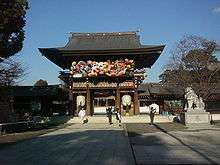Samukawa Shrine
| Samukawa Shrine 寒川神社 | |
|---|---|
|
Honden of Samukawa Shrine | |
| Information | |
| Dedicated to | Samukawa Daimyojin |
| Founded | unknown |
| Address | 3916 Miyayama, Samukawa-cho, Koza-gun, Kanagawa |
| Website |
www |
|
| |
Samukawa Shrine (寒川神社 Samukawa jinja) is a Shinto shrine in the town of Samukawa in Kanagawa Prefecture, Japan. The shrine is located on the bank of the Sagami River, about eight kilometers from the river’s mouth.
History
The origins of Samukawa Jinja are unknown. Unverifiable shrine legend states that it was founded during the reign of Emperor Yūryaku (418-479). The main kami of Samukawa Jinja is the Samukawa Daimyojin, an amalgamation of the male Samukawa-hiko no mikoto (寒川比古命) and the female Samukawa-hime no mikoto (寒川比女命). Both were local kami.
The earliest written records indicate that the shrine was rebuilt in the year 727, and its name also appears in the Shoku Nihon Kōki entry for the year 846.
Samukawa was designated as the chief Shinto shrine (ichinomiya) for the former Sagami province. [1]
From 1871 through 1946, Sumakawa was officially designated one of the Kokuhei Chūsha (国幣中社), meaning that it stood in the mid-range of ranked, nationally significant shrines.
Festivals

The main festival of the shrine is held annually on September 20, and features yabusame performances. During the Setsubun festival in February, illuminated paper figures are hung from the main gate in a style similar to that of the Nebuta in Aomori Prefecture.[2]
See also
Notes
- ↑ "Nationwide List of Ichinomiya," p. 1.; retrieved 2011-08-09
- ↑ Plutschow. (1996). Matsuri: The Festivals of Japan, p. 173.
References
- Plutschow, Herbert and P.G. O'Neil. (1996). Matsuri: The Festivals of Japan. London: Routledge. ISBN 9781873410639; OCLC 36221577
Coordinates: 35°22′43″N 139°22′53″E / 35.37861°N 139.38139°E
